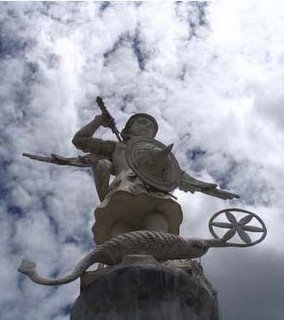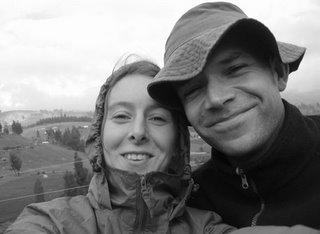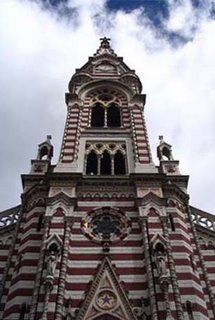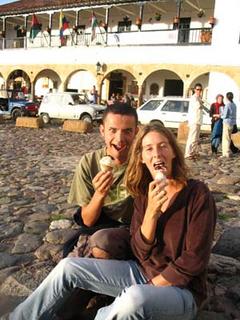
 Beyond the simple border crossing into Ecuador and a short stop at Ibarra, we made our way to Otavalo and supposedly the largest market on the continent. The animal market was quite an experience (Louise wanted to buy a piglet for US$15) and we also found some particularly large cabbages. I have to admit the rest was largely Andean tat, pan pipes (which made me think of Hounslow precinct’s buskers), ‘artisan’ works, and relatively overpriced alpaca ponchos, gloves, socks, hats and the like that seem to be a mainstay for the masses of middle-aged American holiday makers that are drawn to the town. We swiftly hot footed our way past the stalls to the food market where I enjoyed a delicious hog roast for lunch.
Beyond the simple border crossing into Ecuador and a short stop at Ibarra, we made our way to Otavalo and supposedly the largest market on the continent. The animal market was quite an experience (Louise wanted to buy a piglet for US$15) and we also found some particularly large cabbages. I have to admit the rest was largely Andean tat, pan pipes (which made me think of Hounslow precinct’s buskers), ‘artisan’ works, and relatively overpriced alpaca ponchos, gloves, socks, hats and the like that seem to be a mainstay for the masses of middle-aged American holiday makers that are drawn to the town. We swiftly hot footed our way past the stalls to the food market where I enjoyed a delicious hog roast for lunch. 

The meat market was a bit of an eyeful with various organs, hooves and slabs of flesh lying around, but I suppose it is a case of waste not want not when you live in a continent that is so obviously shafted by the evils of the global economy. 
Arriving in the capital, Quito, a few days later was, after the initial romantic night time vista of the city’s twinkling lights up the mountain, a distinct disappointment. 
It has to be the most underwhelming city we have come across following its high billing in what we have discovered are the largely unreliable, ill advised and badly researched ‘travel guides’.  The dismal, rainy weather and city attitude rather reminded of drab, second rate London streets in winter, without all the world class cultural events, art and music we come to expect in Europe.
The dismal, rainy weather and city attitude rather reminded of drab, second rate London streets in winter, without all the world class cultural events, art and music we come to expect in Europe.  We were left chasing our tails again as we found the derelict, abandoned and distinctly closed national gallery alongside more predictable Andean street art and more tat (yet more ‘travel guide’ advice). One consolation was that our hostel was very cheap (a recommendation from an American poet we met in Columbia) though we discovered afterwards that rooms, rather darkly, could be rented by the hour.
We were left chasing our tails again as we found the derelict, abandoned and distinctly closed national gallery alongside more predictable Andean street art and more tat (yet more ‘travel guide’ advice). One consolation was that our hostel was very cheap (a recommendation from an American poet we met in Columbia) though we discovered afterwards that rooms, rather darkly, could be rented by the hour. 
Ecuador did brighten eventually. We arrived in Baños, finally with some sunshine, and the town’s wonderful thermal baths set, dramatically, in a volcanic valley surrounded by a mountainous backdrop. Unfortunately, we enjoyed the best of the hot springs, Piscinas de la Virgen, a little too much and forgot to take photographs of the floodlight waterfall tumbling down the adjacent volcano at night time, literally twenty feet from the hot springs.  Heaven after a year of cold ‘showers’ (quite often we have found a shower really is just a stop tap that has been plumbed a little higher than usual), followed by a plunge under an icy shower and a dip in a chilly pool. It was a strange, skin tingling sensation getting back into the hot water, which was at a perfect temperature. On leaving we both felt energised, but afterwards quickly fell asleep, exhausted.
Heaven after a year of cold ‘showers’ (quite often we have found a shower really is just a stop tap that has been plumbed a little higher than usual), followed by a plunge under an icy shower and a dip in a chilly pool. It was a strange, skin tingling sensation getting back into the hot water, which was at a perfect temperature. On leaving we both felt energised, but afterwards quickly fell asleep, exhausted.  Following another day of hot baths we headed for the fabled Nariz del Diablo, the Devil’s Nose Train, described in its programme as ‘The World’s Most Difficult Railway’. Apparently hundreds died during its construction; it plunges down a mountain, then zigzags backwards and forwards down an almost sheer precipice.
Following another day of hot baths we headed for the fabled Nariz del Diablo, the Devil’s Nose Train, described in its programme as ‘The World’s Most Difficult Railway’. Apparently hundreds died during its construction; it plunges down a mountain, then zigzags backwards and forwards down an almost sheer precipice.  We joined the throng of other gringos on the roof of the train at 6.30am to arrive at the foot of the mountain, somewhat windswept, five hours later (the mountain descent itself takes about an hour). We must have travelled through every season taking in our fair share of grey clouds, then ice, blazing sunshine and finally rain on our ascent up the mountain.
We joined the throng of other gringos on the roof of the train at 6.30am to arrive at the foot of the mountain, somewhat windswept, five hours later (the mountain descent itself takes about an hour). We must have travelled through every season taking in our fair share of grey clouds, then ice, blazing sunshine and finally rain on our ascent up the mountain.  I was the only one cracking jokes on the way back up but I managed to garner a few forced smiles from under the sleeping bags, raincoats and whatever bits of plastic sheeting were available. The train ride down the mountain offered a stunning panorama and although we derailed on the way back (I was particularly excited by this but the batteries in the effing camera ran out, I guess I will never make a photographer) it was well worth the effort.
I was the only one cracking jokes on the way back up but I managed to garner a few forced smiles from under the sleeping bags, raincoats and whatever bits of plastic sheeting were available. The train ride down the mountain offered a stunning panorama and although we derailed on the way back (I was particularly excited by this but the batteries in the effing camera ran out, I guess I will never make a photographer) it was well worth the effort.
Following a herculean fifty two hour bus ride (over three days, to make time for our excesses in Columbia) we arrived in Cusco, Peru a few days ago, very, very tired and breathless from the altitude. We are bound for the Machu Pichu by train tomorrow (we have bucked the four day Inca Trail trek, as we run out of time, have seen plenty of miles in the jungle and it seems we might see more - including other ruins in and around the Inca Citadel and the Sacred Valley - before we head to Isla del Sol and lake Titicaca in Bolivia.
November 07, 2005
Nariz Del Diablo, Ecuador
October 26, 2005
Bogota, Columbia
We have been making time after enjoying Columbia a little too much. Considering we intended to avoid the country, we spent over a month there. This culminated in a week long stay in the capital, Bogotá, at a smashing hostel, dubbed almost accurately, as the best in Latin America. Of course it was something of a gringo social/party haunt.
 On one heady night, with a pack of foreigners, we descended on the Cha Cha Club on the top floor of the Hilton Hotel (and it’s views of the whole city), fuelled with bellyfuls of Cubre Libre rum cocktails. Not surprisingly we danced to the funky house music until the wee hours and beyond (I heard some people were dancing on tables).
On one heady night, with a pack of foreigners, we descended on the Cha Cha Club on the top floor of the Hilton Hotel (and it’s views of the whole city), fuelled with bellyfuls of Cubre Libre rum cocktails. Not surprisingly we danced to the funky house music until the wee hours and beyond (I heard some people were dancing on tables).
We made a fine exit from Columbia over the breathtaking landscape of the Andes, punctuated with the ubiquitous bus searches and a good frisking for the boys by soldiers clutching machine-guns (something of a shock at first, but you get used to it. The locals are among the friendliest we have come across in Latin America – certainly no reason not to go. We did not see a single fire bombing, murder, guerrilla attack or hijacking that all the books propound with their fearful propaganda, touch wood, although one passenger saw fit to show Louise his gun. He had a licence of course. I suppose that kind of machismo is acceptable in the US, but it was just a little bit weird and slightly unnerving.)
October 10, 2005
October 06, 2005
Pulling the crowds
 I finally managed to achieve one of the highlights of my trip in, of all places, Cartagena, Columbia. At last, away from the geeky, slighty-asthmatic-NHS-jam-jar-glasses-taped-to-their-rims-with-plaster entourage in blighty. All the old boys in this seeming ill-fated nation sit around the famous Plaza Bolivar in the city´s colonial centre playing chess. Fountains tinkle in the background, while the Latin American gentlemen muse over classic variations of the Ruy Lopez, sipping coffee, dressed to the nines in creased trousers and shoes in the tropical heat.
I finally managed to achieve one of the highlights of my trip in, of all places, Cartagena, Columbia. At last, away from the geeky, slighty-asthmatic-NHS-jam-jar-glasses-taped-to-their-rims-with-plaster entourage in blighty. All the old boys in this seeming ill-fated nation sit around the famous Plaza Bolivar in the city´s colonial centre playing chess. Fountains tinkle in the background, while the Latin American gentlemen muse over classic variations of the Ruy Lopez, sipping coffee, dressed to the nines in creased trousers and shoes in the tropical heat. After twenty minutes or so, hopping excitedly from one foot to the other one of the fellows broke from their banter, the young upstarts take a regular whipping from the old masters, and offered me a game. I could barely contain my excitement as we sat down exchanging pleasantries in Español. After failing to consolidate a clearly winning position (I had pulled a crowd at this stage as you can see from the picture) I, as the phrase goes, bottled it and lost. I managed (with the young gringo attacting more and more of an audience) to pull back the second game and then drew the third. I lost further three games to finish 4 1/2 - 1 1/2. Somewhat exhausted and overheating (Cartagena is one of the most beautiful and hottest cities on the continent) we shook hands and I thanked him kindly for the games, which I enjoyed thoroughly. So much more interesting and sophisticated than the geeks back home.
 The following day, I arrive in the plaza dressed smartly (Come on, I had shorts and a tee shirt on. I am English) and clean shaven. Pleased at least that I had won a game I felt I could at least hold my own with these boys, was not just another gringo chancer and I could return for a second bout with my head held high. This is after all a memory that will stay with me for the rest of my life and will, without doubt find its way into the book. I should probably also mention that etiquette dictates that the loser pays for the hire of the tables. A princely sum of two thousand pesos, around fifty pence. An old chap who had the day before, given me pointers on where I had lost one of the games I should have won motioned for a game, to my delight, nodding at one of the tables. I sat down, grim faced and quickly got the advantange in the first game, this time making sure I pressed my upper hand for a good win. The old fellow, sharply dressed in fitted brown trousers and a fine shirt who must have been fifty or sixty, introduced himself as Frederico and explained he wanted a game after seeing me play the day before. I cannot think of a better compliment. The second game we drew before I lost all the remaining games, including a dramatic final decider in which he played a crushing sacrificial combination that I had seen but was prepared to contest. Chess after all should be played with a bit of passion.
The following day, I arrive in the plaza dressed smartly (Come on, I had shorts and a tee shirt on. I am English) and clean shaven. Pleased at least that I had won a game I felt I could at least hold my own with these boys, was not just another gringo chancer and I could return for a second bout with my head held high. This is after all a memory that will stay with me for the rest of my life and will, without doubt find its way into the book. I should probably also mention that etiquette dictates that the loser pays for the hire of the tables. A princely sum of two thousand pesos, around fifty pence. An old chap who had the day before, given me pointers on where I had lost one of the games I should have won motioned for a game, to my delight, nodding at one of the tables. I sat down, grim faced and quickly got the advantange in the first game, this time making sure I pressed my upper hand for a good win. The old fellow, sharply dressed in fitted brown trousers and a fine shirt who must have been fifty or sixty, introduced himself as Frederico and explained he wanted a game after seeing me play the day before. I cannot think of a better compliment. The second game we drew before I lost all the remaining games, including a dramatic final decider in which he played a crushing sacrificial combination that I had seen but was prepared to contest. Chess after all should be played with a bit of passion.
 I have included some pictures of this marvellous city, including a shot of the former slave trading square, Plaza de los Coches that now more typically is the jumping on point for romantic horse-drawn (and in the evenings candle-lit) tours of Cartagena´s Old town. The town, full name Cartagena de Indias, was founded in 1533 and was one of the New World´s first Spanish cities, the main port from which much of the continent´s wealth was spirited away to Europe. It was also home to the magical realist, Gabriel Garcia Marquez in the 1940s who most famously wrote One Hundred Years of Solitude.
I have included some pictures of this marvellous city, including a shot of the former slave trading square, Plaza de los Coches that now more typically is the jumping on point for romantic horse-drawn (and in the evenings candle-lit) tours of Cartagena´s Old town. The town, full name Cartagena de Indias, was founded in 1533 and was one of the New World´s first Spanish cities, the main port from which much of the continent´s wealth was spirited away to Europe. It was also home to the magical realist, Gabriel Garcia Marquez in the 1940s who most famously wrote One Hundred Years of Solitude.
September 27, 2005
September 17, 2005
Pelican sunset in Choroni, Venezuela
Well, we finally made good our glorious exit from Suriname and are both delighted to be on the move again. We were becoming increasingly twitchy after we decided to stay on for a bit longer than we really wanted to. But three weeks is three weeks. Aint so bad. With our flights paid for and some hard graft behind us, we flew to Port of Spain, Trinidad. An odd journey, but as I probably mentioned before, it’s easier to fly to Holland from Suriname than to the rest of Latin America. We managed to get a quick look at the mountains at dawn, standing outside the airport waiting for our connection. Very beautiful, but we had our hearts set on Venezuela and with good reason. Somewhat exhausted we arrived in Caracas the following day and were whisked through the concrete jungle that is Venezuela’s capital. Caracas turned out to be very expensive, relatively, so after a day or so of failing to find some much needed culture (the contemporary art gallery, supposed to be the best in the continent was closed for ten days – we ended up going to a kids museum!) we decided to head for the beach. We did manage a look at the Plaza Bolivar (and a chatted with some local old boys who were sipping thimbles of coffee while getting a shoe shine), but much of the colonial architecture and history of the city was demolished in the 70s oil boom in favour of concrete skyscrapers. That said, we had a great night at an English bar and the sounds of some classic Brit music (Beatles, Pink Floyd: We don’t need no education) – I ended up dancing arm in arm with a couple of really friendly Venezuelan lads and have to admit to being the drunken instigator of a sing-song rendition of Sting’s classic I’m an Englishman in… Venezuela. You can’t take me anywhere. The day before the beach we chanced our arm on the Swiss-run teleferico which soars 1,600 meters up the mountain that dominates the Caracas skyline. I’m not the biggest fan of cable cars, but it really was something else. Jaw-dropping, panoramic views of the huge, sprawling city combined with Caribbean ocean vistas and a path ambling down to a mountain village and the sea. The following day we were haring off to the coast after a two hour wait for our connection. In Latin America you need patience - we got chatting with a couple from Coventry. We got on to the diablo ride over the mountain and the bus broke down thirty seconds after pulled out of the station. But after a fiddle under the bonnet we were treated to a dramatic drive through cloud and rainforest, horns blaring at every turn with the sounds of salsa blasting from the speakers of the bus. Two hours later we arrived in Choroni and Puerto Columbia, where we are now. It’s paradise. Palm-lined, Caribbean beaches and aquamarine water with mountains looming in the distance. Needless to say we were slightly sunburnt after the first day. Mad dogs and Englishmen. Hiring a beach umbrella here is an absolute necessity. And the waves are hardcore. I have unwittingly managed to pull off several gymnastic somersaults in the sea. Well, that’s all so far. It looks like we might be making the trip to Columbia now after all. Two travellers have given us the low down on some wonderful beaches and the world’s ‘most inexpensive’ scuba diving. It’s something I have always wanted to try. |
September 02, 2005
When the work is done...
We have finished most of the filming (more than 30 hours) we intend to do while we are in Latin America.
Further updates on this sites will be primarily for photographs.
July 22, 2005
Wanwan futu e doro bergi
As part of our education project in the tropical rainforest of Suriname, South America, we organised a field trip for 334 schoolchildren. Most were between six to 10-years-old and were from the village of Brownsweg.
This transmigration village, 13 km from Brownsberg mountain nature park, was formed from 5,000 people from several maroon tribes that formerly lived along the Surinam river. In 1964 they were relocated by the Surinamese government when the gates of the Afobaka Dam (Afobaka means grandmothers back) closed, forming the Brokopondo Lake. The hydro-electric dam now powers the capital, Paramaribo. Brownsweg has since become characterised by high unemployment and the prevalence of illegal gold-mining.
Almost three quarters of the youngsters from the village, despite living so close to the mountain, had not set foot on its slopes previously. Thanks to funding from WWF, we organised transportation and food, an interpretive trail through the rainforest, an educational video on the biodiversity of Brownsberg, a viewing of the village from the mountain using binoculars (for most this was also a first) and an art project including two murals. We also filmed HDV footage, which we hope will prove persuasive in future funding negotiations. (Wanwan futu e doro bergi translates to Step by step we climb the mountain).
June 05, 2005
Rainforest School
We are also developing an education program and publicity material [such as the poster above] for Stinasu, the foundation for nature conservation in Suriname. The education program and documentary focus on animal behaviour, rainforest ecosystems and conservation issues such as the impact of gold mining on vegetation, biodiversity and health. We are also working with leading primate anthropologists to capture footage (HDV equipment) of species unique to the Guianas such as the bearded saki as well as the spider monkey, the white faced saki, howler monkey, capuchin and other animals. We are in Suriname on Brownsberg mountain [on the link map below near Brownsweg]:
Click here for a map.



